Computational Analysis on Combustion Control of Diesel Engines Fueled with Ester Alcohol Diesel
Abstract
:1. Introduction
2. Computational Model Construction and Validation
2.1. Construction of Simplified Chemical Kinetic Model
2.2. In-Cylinder Combustion Simulation Model Construction
2.3. Fuel Injection Scheme and Model Verification
3. Results and Analysis
3.1. Analysis of Diesel Engine Combustion Process
3.2. Emission Generation Characteristics
4. Conclusions
- (1)
- The addition of ester-alcohol fuel augments in-cylinder combustion reaction activity, promoting the progression of in-cylinder combustion. Furthermore, as the blending ratio of ester-alcohol fuel increases, the advance of the heat release center, CA50, becomes more pronounced. Due to the superior volatility of ethanol, which stimulates the progression of in-cylinder combustion, the peak values of the maximum combustion pressure and instantaneous heat release rate for HB5E5, HB10E10, and HB15E15 fuels surpass that of pure diesel.
- (2)
- After the inclusion of ester-alcohol, the NOx emission generation volume of blended fuels escalates in comparison to pure diesel. This increase becomes more significant as the blending ratio of hydrogenated biodiesel and ethanol heightens.
- (3)
- After the addition of ester-alcohol, the soot generation volume of blended fuels significantly diminishes relative to pure diesel. It is primarily distributed in areas with high equivalence ratios and high temperatures. The distribution of acetylene (C2H2) in-cylinder is approximately similar to soot. This phenomenon primarily stems from the high oxygen content of blended fuels, increasing the chance of diesel-oxygen contact, thereby reducing soot production due to oxygen-deficient mixtures.
Author Contributions
Funding
Data Availability Statement
Conflicts of Interest
References
- Xu, Z. Trends in the Development of Traditional Fossil Energy and New Energy Under the “Dual Carbon” Goal. Petrochem. Ind. Technol. 2022, 29, 188–190. [Google Scholar]
- Min, J. Current Status and Prospects of Advanced Bio-Liquid Fuels. Green Low Carbon Petrochem. Green Pet. Petrochem. 2023, 8, 22–27. [Google Scholar]
- Kesharvani, S.; Verma, T.N.; Gaurav, D. Computational analysis of chlorella protothecoides biofuels on engine combustion, performance and emission. Sustain. Energy Technol. Assess. 2023, 55, 102972. [Google Scholar] [CrossRef]
- Szwaja, S.; Gruca, M.; Pyrc, M.; Juknelevičius, R. Glycerol as an Anti-Knock Additive and Secondary Fuel as a Substitute for Gasoline-Based Fuels for the IC Engine. Energies 2023, 16, 4940. [Google Scholar] [CrossRef]
- Zhou, J.; He, Y.; Lyu, Y.; Wang, K.; Che, Y.; Wang, X. Long-Term Electricity Forecasting for the Industrial Sector in Western China Under the Carbon Peaking and Carbon Neutral Targets. Energy Sustain. Dev. 2023, 73, 174–178. [Google Scholar] [CrossRef]
- Li, P.; Sun, W.; Zhang, Z.; He, Y.; Wang, Y. Forecast of Renewable Energy Penetration Potential in the Goal of Carbon Peaking and Carbon Neutrality in China. Sustain. Prod. Consum. 2022, 34, 541–551. [Google Scholar] [CrossRef]
- Szelangiewicz, T.; Żelazny, K. Reducing CO2 Emissions during the Operation of Unmanned Transport Vessels with Diesel Engines. Energies 2023, 16, 4818. [Google Scholar] [CrossRef]
- Li, R. Integrating the Composition of Food Waste into the Techno-Economic Analysis of Waste Biorefineries for Biodiesel Production. Bioresour. Technol. Rep. 2022, 20, 2589–2597. [Google Scholar]
- Mubarak, M.; Shaija, A.; Suchithra, T.V. Experimental Evaluation of Salvinia Molesta Oil Biodiesel/Diesel Blends Fuel on Combustion Performance and Emission Analysis of Diesel Engine. Fuel 2021, 287, 119526. [Google Scholar] [CrossRef]
- Molière, M. The Fuel Flexibility of Gas Turbines: A Review and Retrospective Outlook. Energies 2023, 16, 3962. [Google Scholar] [CrossRef]
- Rojas-Reinoso, V.; Duque-Escobar, S.; Guapulema-Guapulema, C.; Soriano, J.A. Study of the Variation of Fuel Pressure to Improve Spraying and the Range of the Injection Jet. Energies 2023, 16, 5472. [Google Scholar] [CrossRef]
- Singh, D.; Sharma, D.; Soni, S.L.; Inda, C.S.; Sharma, S.; Sharma, P.K.; Jhalani, A. A comprehensive review of physicochemical properties, production process, performance and emissions characteristics of 2nd generation biodiesel feedstock: Jatropha curcas. Fuel 2021, 285, 119110. [Google Scholar] [CrossRef]
- Yin, G.; Xiao, B.; Hu, E.; Huang, Z. Automatic Optimization of Acetic Acid Chemical Reaction Kinetics Model Using Neural Network and Bayesian Inversion Method. J. Xi’an Jiaotong Univ. 2023, 57, 130–138. [Google Scholar]
- Ding, Y.; Ezekoye, O.A.; Zhang, J.Q.; Wang, C.; Lu, S. The Effect of Chemical Reaction Kinetic Parameters on the Bench-Scale Pyrolysis of Lignocellulosic Biomass. Fuel 2018, 232, 147–153. [Google Scholar] [CrossRef]
- Telli, G.D.; Zu, G.Y.; Lanzanova, T.D.M.; Martins, M.E.S.; Rocha, L.A.O. An Experimental Study of Performance, Combustion and Emissions Characteristics of an Ethanol HCCI Engine Using Water Injection. Appl. Therm. Eng. 2022, 204, 118003. [Google Scholar] [CrossRef]
- Singh, D.; Sharma, D.; Soni, S.L.; Sharma, S.; Sharma, P.K.; Jhalani, A. A Review of Feedstocks, Production Processes, and Yield for Different Generations of Biodiesel. Fuel 2020, 262, 116553. [Google Scholar] [CrossRef]
- Zhang, W.; Han, L. Current Status and Development Trend of Biodiesel Research at Home and Abroad. Chem. Eng. Manag. 2021, 12, 72–73. [Google Scholar]
- Shi, W.; Li, J.; He, B.; Yan, F.; Cui, Z.; Wu, K.; Lin, L.; Qian, X.; Cheng, Y. Biodiesel Production from Waste Chicken Fat with Low Free Fatty Acids by an Integrated Catalytic Process of Composite Membrane and Sodium Methoxide. Bioresour. Technol. 2013, 139, 316–322. [Google Scholar] [CrossRef]
- Szabados, G.; Bereczky, Á. Experimental Investigation of Physicochemical Properties of Diesel, Biodiesel and TBK-Biodiesel Fuels and Combustion and Emission Analysis in CI Internal Combustion Engine. Renew. Energy 2018, 121, 568–578. [Google Scholar] [CrossRef]
- Nabin, M.; Rasul, M.G.; Anwar, M.; Mullins, B. Emission and Combustion Characteristics of Diesel Engine Using New Series of Non-Edible Biodiesels. Renew. Energy 2019, 140, 647–657. [Google Scholar] [CrossRef]
- Martos, F.J.; Soriano, J.A.; Braic, A.; Fernández-Yáñez, P.; Armas, O. A CFD Modelling Approach for the Operation Analysis of an Exhaust Backpressure Valve Used in a Euro 6 Diesel Engine. Energies 2023, 16, 4112. [Google Scholar] [CrossRef]
- Sathyamurthy, R.; Balaji, D.; Gorjian, S.; Muthiya, S.J.; Bharathwaaj, R.; Vasanthaseelan, S.; Essa, F.A. Performance Combustion and Emission Characteristics of a DI-CI Diesel Engine Fueled with Corn Oil Methyl Ester Biodiesel Blends. Sustain. Energy Technol. Assess. 2021, 43, 100981. [Google Scholar] [CrossRef]
- Aydn, S. Comprehensive Analysis of Combustion, Performance and Emissions of Power Generator Diesel Engine Fueled with Different Source of Biodiesel Blends. Energy 2020, 205, 118074. [Google Scholar] [CrossRef]
- Knothe, G. Analysis of Oxidized Biodiesel by 1H-NMR and Effect of Contact Area with Air. Eur. J. Lipid Sci. Technol. 2006, 108, 493–500. [Google Scholar] [CrossRef]
- Cravero, C.; Marsano, D. Numerical Simulation of Melted Glass Flow Structures inside a Glass Furnace with Different Heat Release Profiles from Combustion. Energies 2023, 16, 4187. [Google Scholar] [CrossRef]
- Sun, W.; Zheng, C.; Gou, X.; Ju, Y. A Path Flux Analysis Method for the Reduction of Detailed Chemical Kinetic Mechanisms. Combust. Flame 2010, 157, 1298–1307. [Google Scholar] [CrossRef]
- Sx, A.; Jie, X.B.; Fan, W.B.; Li, X. Reduction of Large-Size Combustion Mechanisms of n-Decane and n-Dodecane with an Improved Sensitivity Analysis Method. Combust. Flame 2020, 222, 326–335. [Google Scholar]
- Tamas, T. Applications of Sensitivity Analysis to Combustion Chemistry. Reliab. Eng. Syst. Saf. 1997, 57, 41–48. [Google Scholar]
- Qi, P. Study on the Kinetic Mechanism of Low-Temperature Combustion in Diesel Engines. Ph.D. Thesis, Tianjin University, Tianjin, China, 2017. [Google Scholar]
- Aklouche, F.Z.; Hadhoum, L.; Loubar, K.; Tazerout, M. A Comprehensive Study on Effect of Biofuel Blending Obtained from Hydrothermal Liquefaction of Olive Mill Waste Water in Internal Combustion Engine. Energies 2023, 16, 2534. [Google Scholar] [CrossRef]
- Westbrook, C.K.; Naik, C.V.; Herbinet, O.; Pitz, W.; Mehl, M. Detailed Chemical Kinetic Reaction Mechanism for Biodiesel Components Methyl Stearate and Methyl Oleate. Proc. Combust. Inst. 2011, 33, 383–389. [Google Scholar]
- Campbell, M.F.; Davidson, D.F.; Hanson, R.K.; Westbrook, C. Ignition Delay Times of Methyl Oleate and Methyl Linoleate Behind Reflected Shock Waves. Proc. Combust. Inst. 2013, 34, 419–425. [Google Scholar] [CrossRef]
- Sarathy, S.M.; Gaïl, S.; Syed, S.A.; Thomson, M.; Dagaut, P. A Comparison of Saturated and Unsaturated C4 Fatty Acid Methyl Esters in an Opposed Flow Diffusion Flame and a Jet Stirred Reactor. Proc. Combust. Inst. 2007, 31, 1015–1022. [Google Scholar] [CrossRef]
- Wang, W.J.; Oehlschlaeger, M.A. A Shock Tube Study of Methyl Decanoate Autoignition at Elevated Pressures. Combust. Flame 2012, 159, 476–481. [Google Scholar] [CrossRef]
- Glaude, P.E.; Herbinet, O.; Bax, S.; Biet, J.; Warth, V.; Battin-Leclerc, F. Modeling of the Oxidation of Methyl Esters—Validation for Methyl Hexanoate, Methyl Heptanoate, and Methyl Decanoate in a Jet-Stirred Reactor. Combust. Flame 2010, 157, 2035–2050. [Google Scholar] [CrossRef]
- Xu, L. Numerical and Experimental Study of Fuel Injection, Stratified Mixture and Combustion Characteristics under Low-Temperature Combustion Mode. Ph.D. Thesis, Shanghai Jiao Tong University, Shanghai, China, 2019. [Google Scholar]
- Zhao, Z. Experimental Study on Combustion and Emission Characteristics of Ethanol/Gasoline/Brown Gas Ternary Fuel Compound Supplied Engine. Ph.D. Thesis, Jilin University, Jilin, China, 2022. [Google Scholar]
- Sun, M. Numerical Calculation Study on the Impact of Multiple Injection Strategies on Engine Combustion and Emission of Biodiesel. Ph.D. Thesis, Huazhong University of Science and Technology, Wuhan, China, 2016. [Google Scholar]
- He, J. Simulation Study on the Impact of Multi-Stage Injection on Engine Performance when Using B20 Biodiesel. Ph.D. Thesis, Southwest Jiaotong University, Chengdu, China, 2019. [Google Scholar]
- Wang, H. Combustion Characteristics and Simulation Analysis of Waste Cooking Oil and its Biodiesel in Industrial Furnace. Ph.D. Thesis, Kunming University of Science and Technology, Kunming, China, 2018. [Google Scholar]
- Li, J.; Li, M.; Zeng, L.; Zhang, Z. Application of Combustion Simulation in the Development of Combustion System for National Six Diesel Engine. Veh. Engine 2021, 252, 40–44. [Google Scholar]
- Vaughn, T.; Hammill, M.; Harris, M.; Marchese, A. Ignition Delay of Bio-Ester Fuel Droplets. SAE Tech. Pap. 2006, 1, 3302. [Google Scholar]
- Fieweger, K.; Blumenthal, R.; Adomeit, G. Self-Ignition of SI Engine Model Fuels: A Shock Tube Investigation at High Pressure. Combust. Flame 1997, 109, 599–619. [Google Scholar] [CrossRef]
- Zuo, L. Study on Combustion and Emission Characteristics of Diesel Engines Fueled with Hydrogenated Biodiesel-Ethanol-Diesel. Ph.D. Thesis, Jiangsu University, Zhenjiang, China, 2020. [Google Scholar]
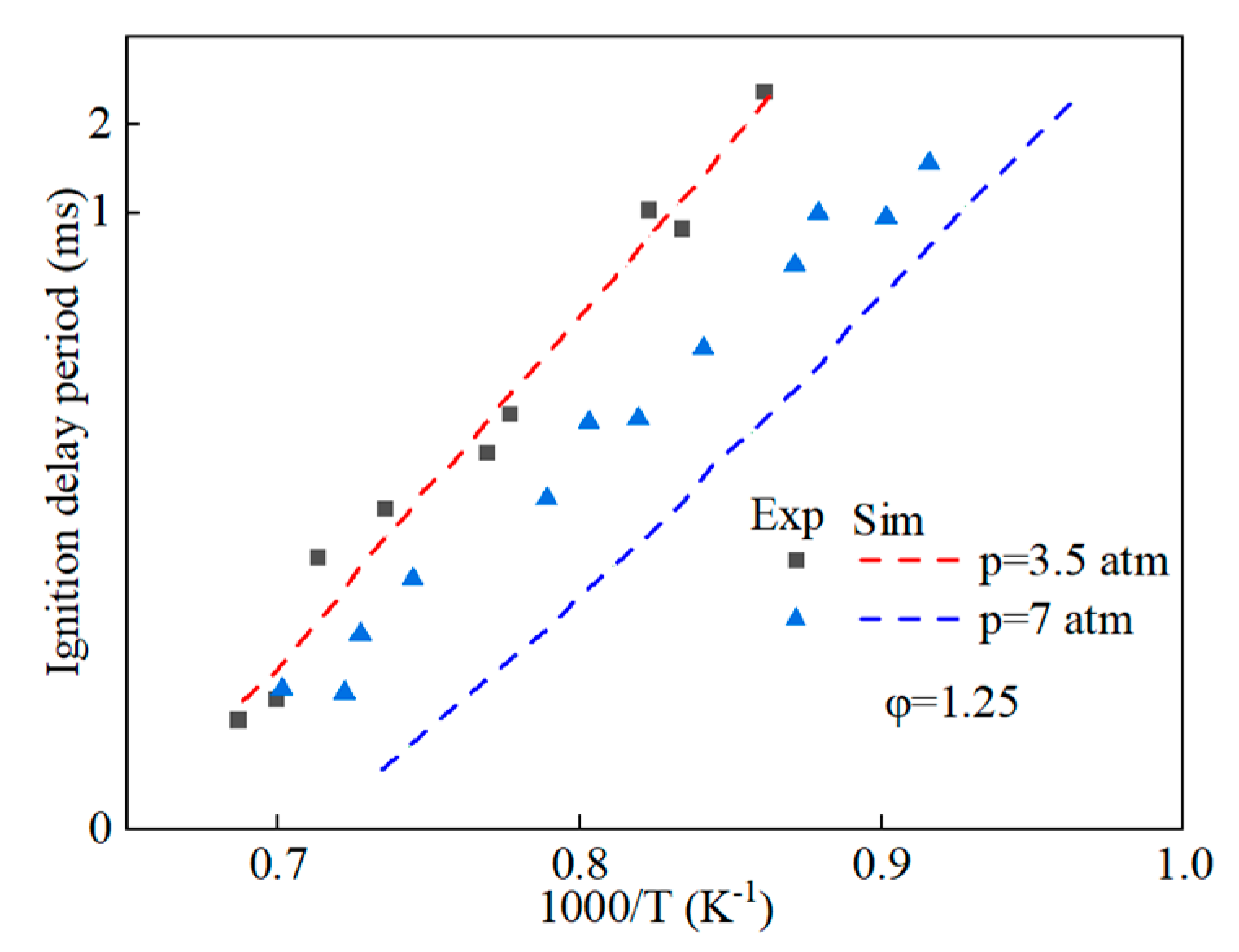
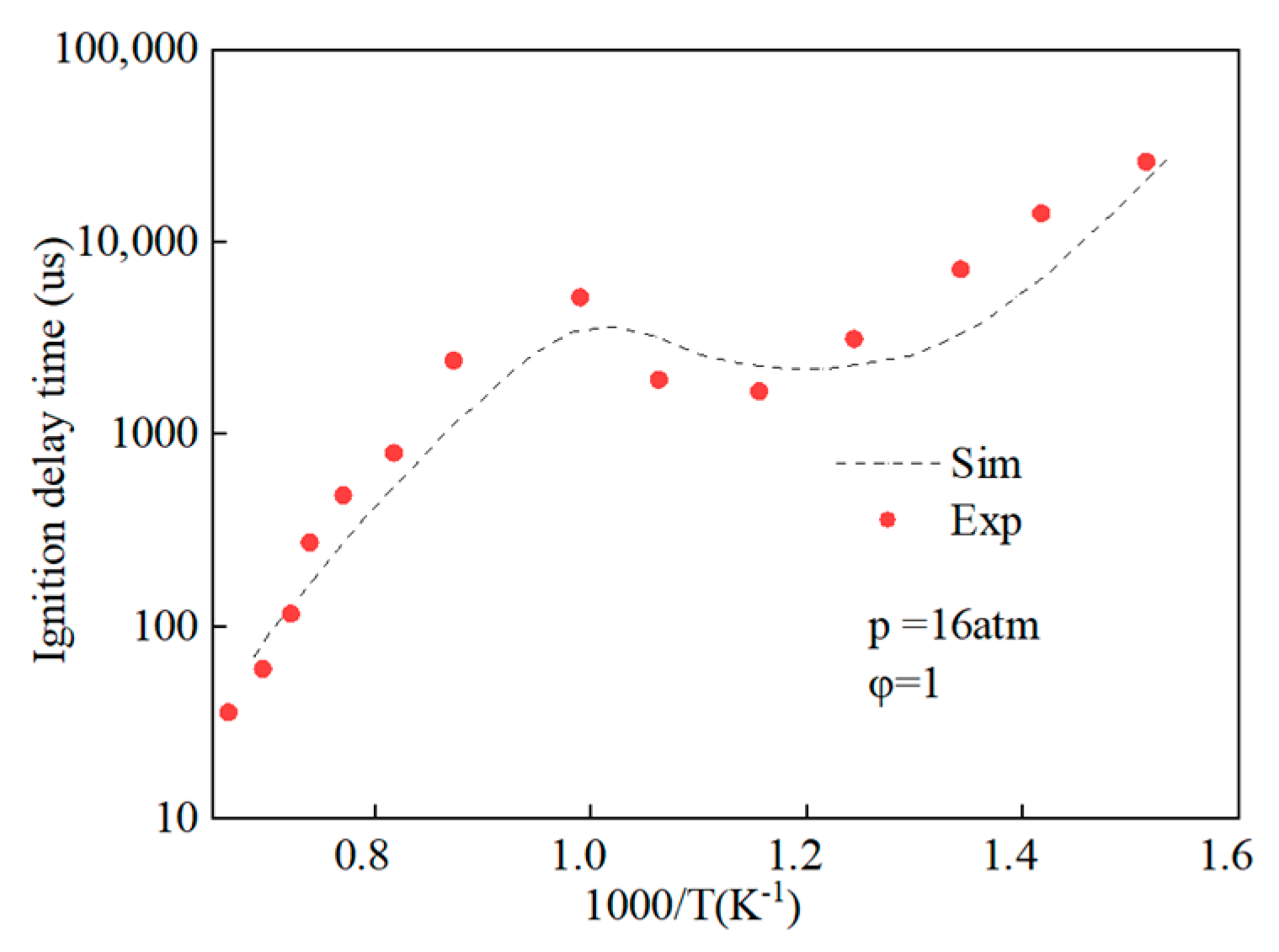

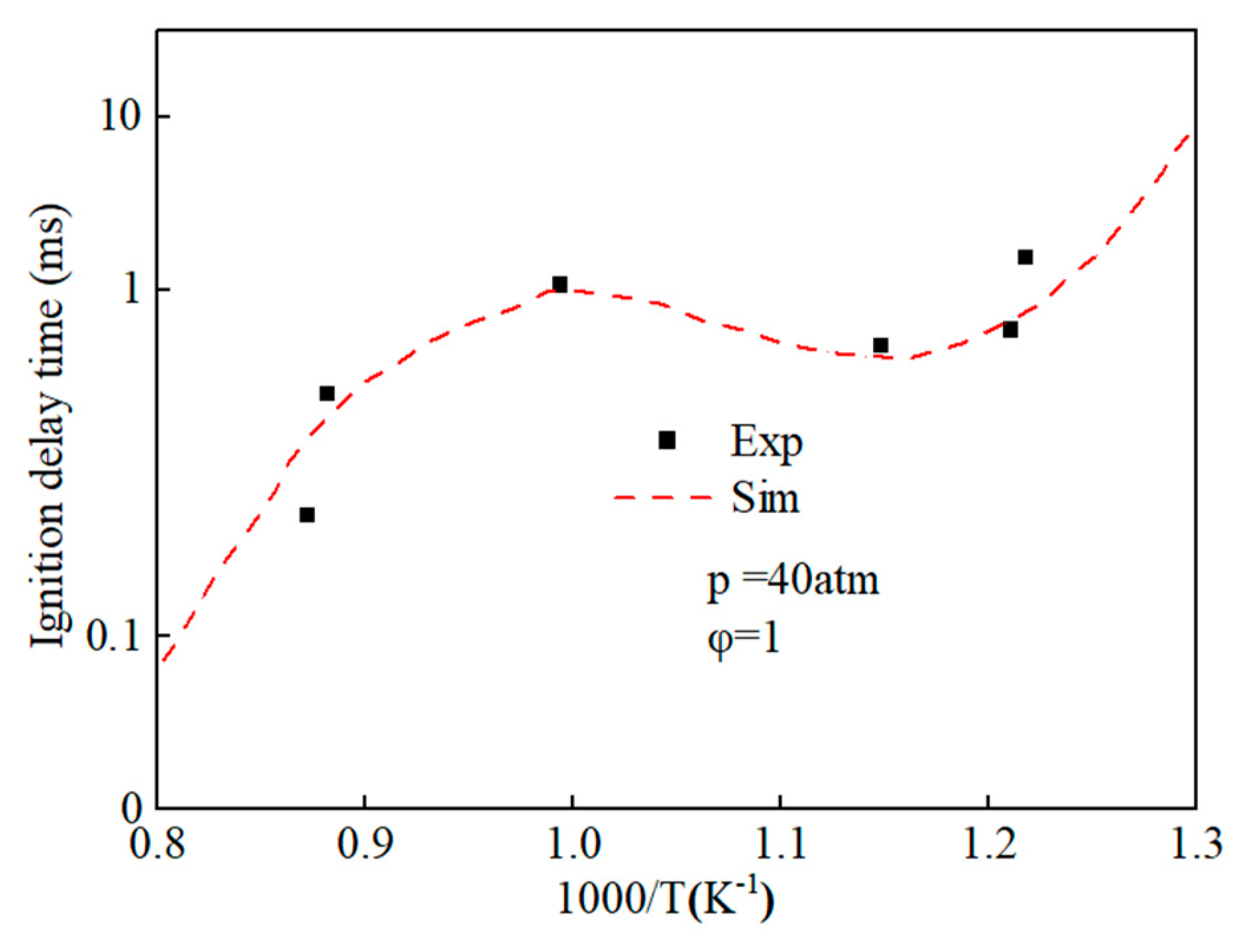
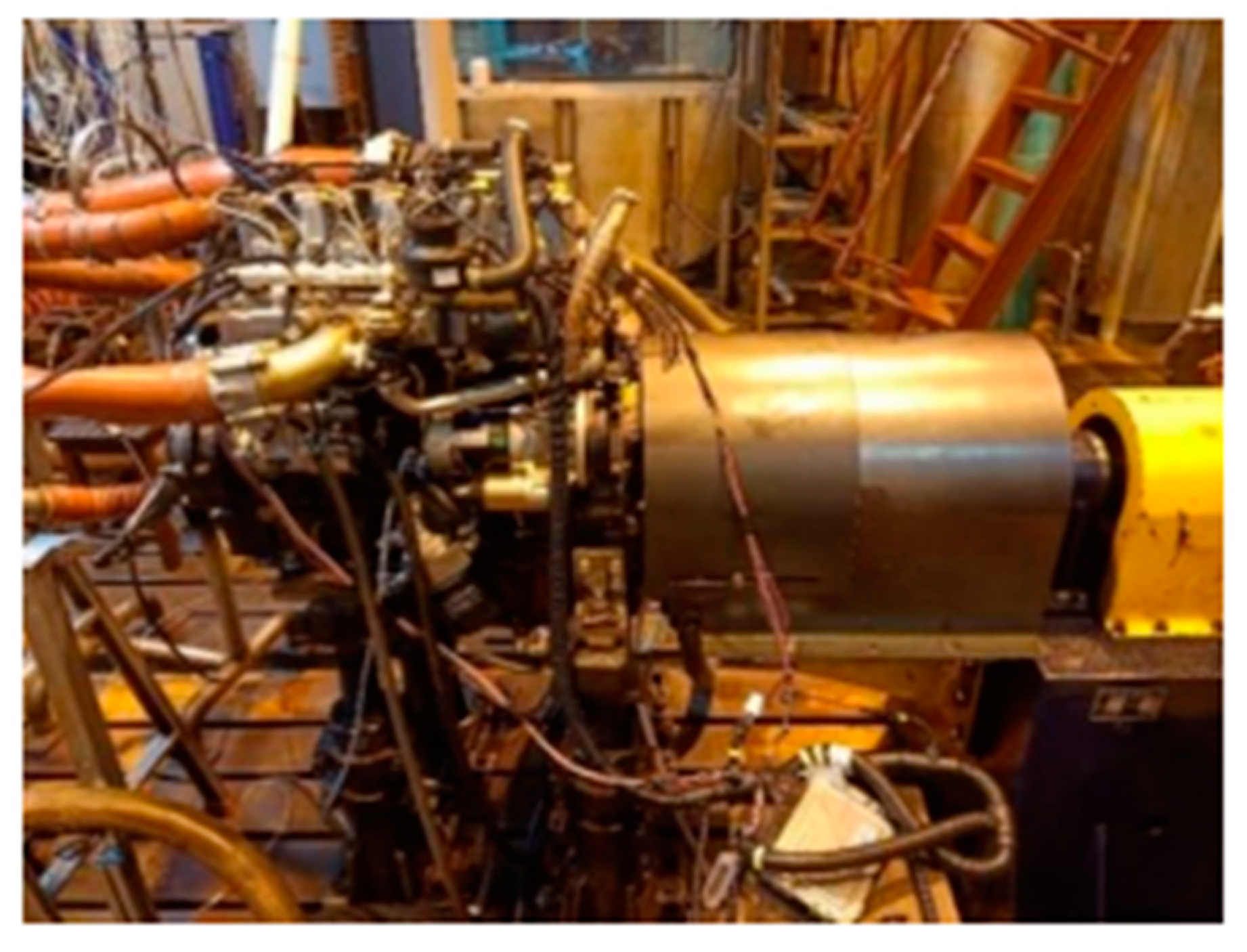
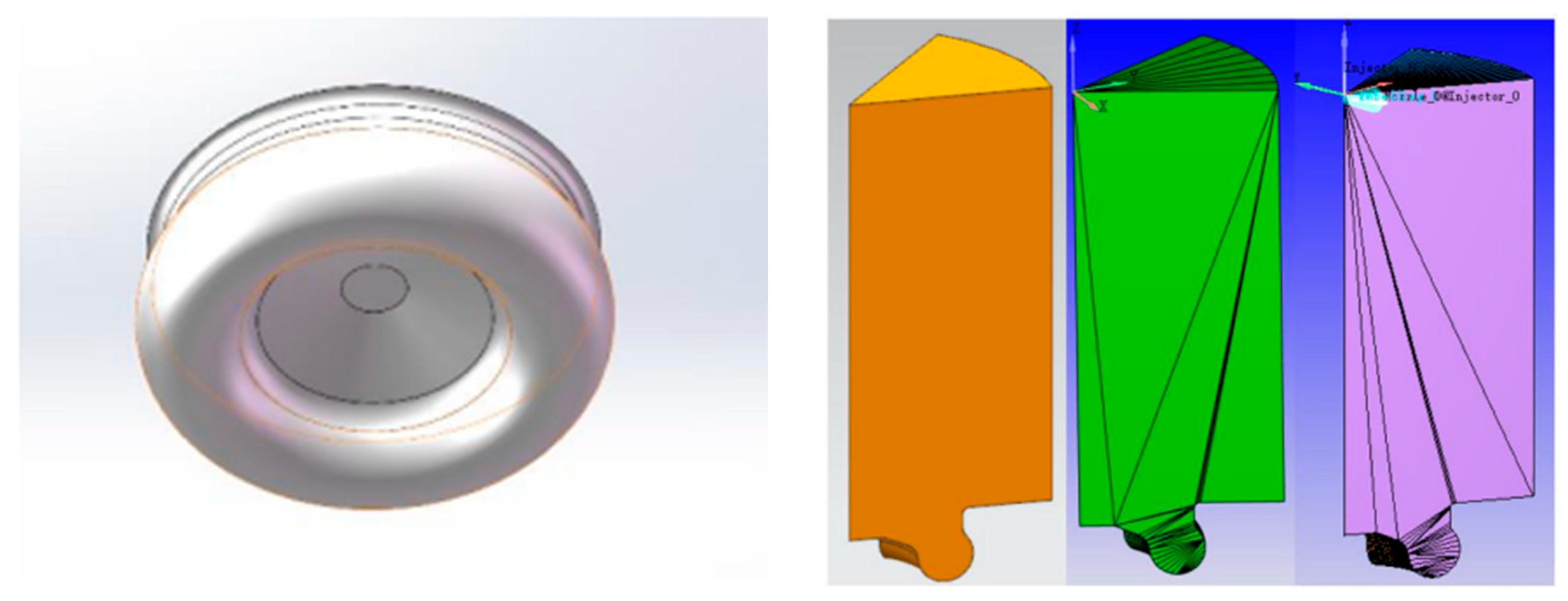
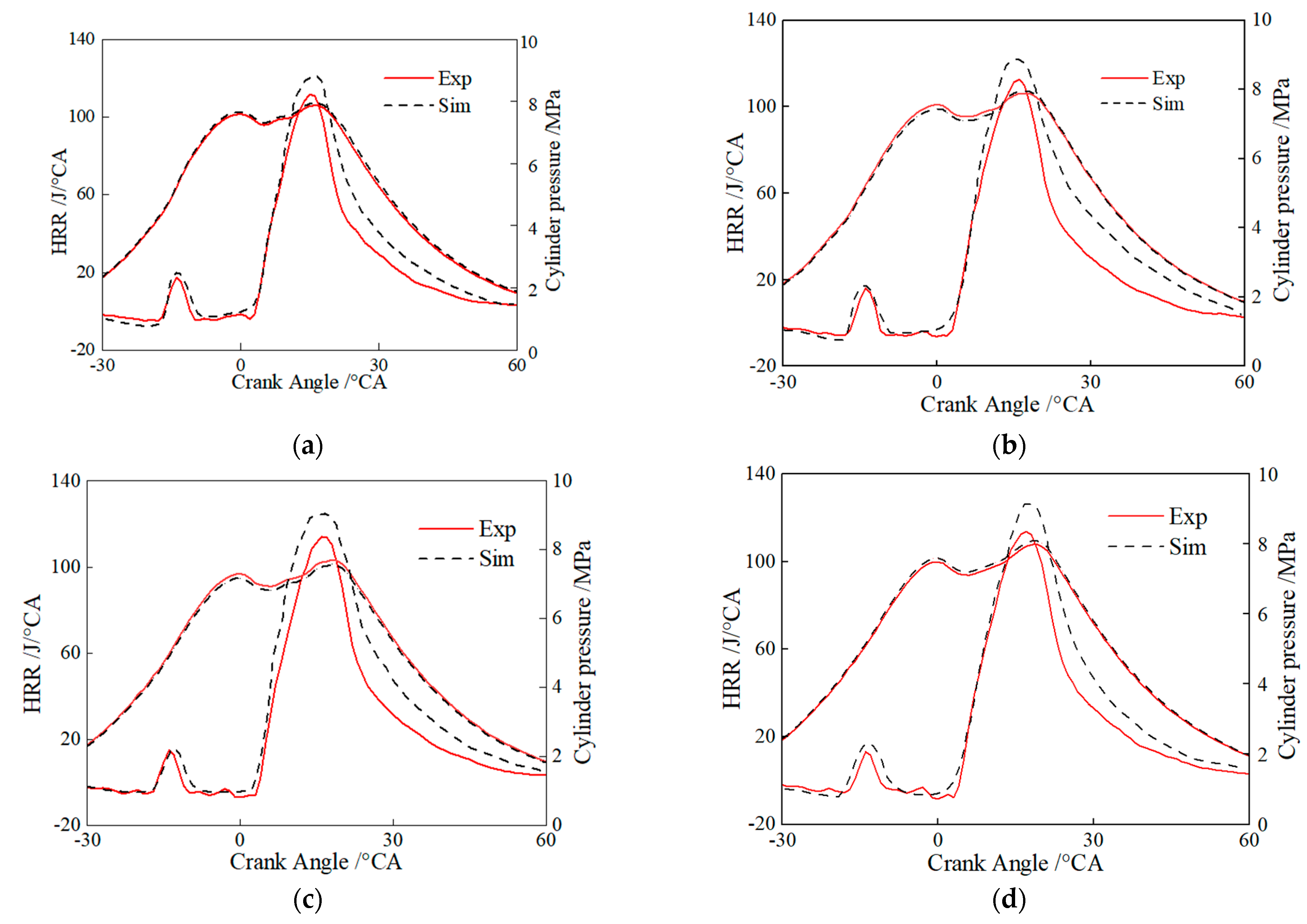

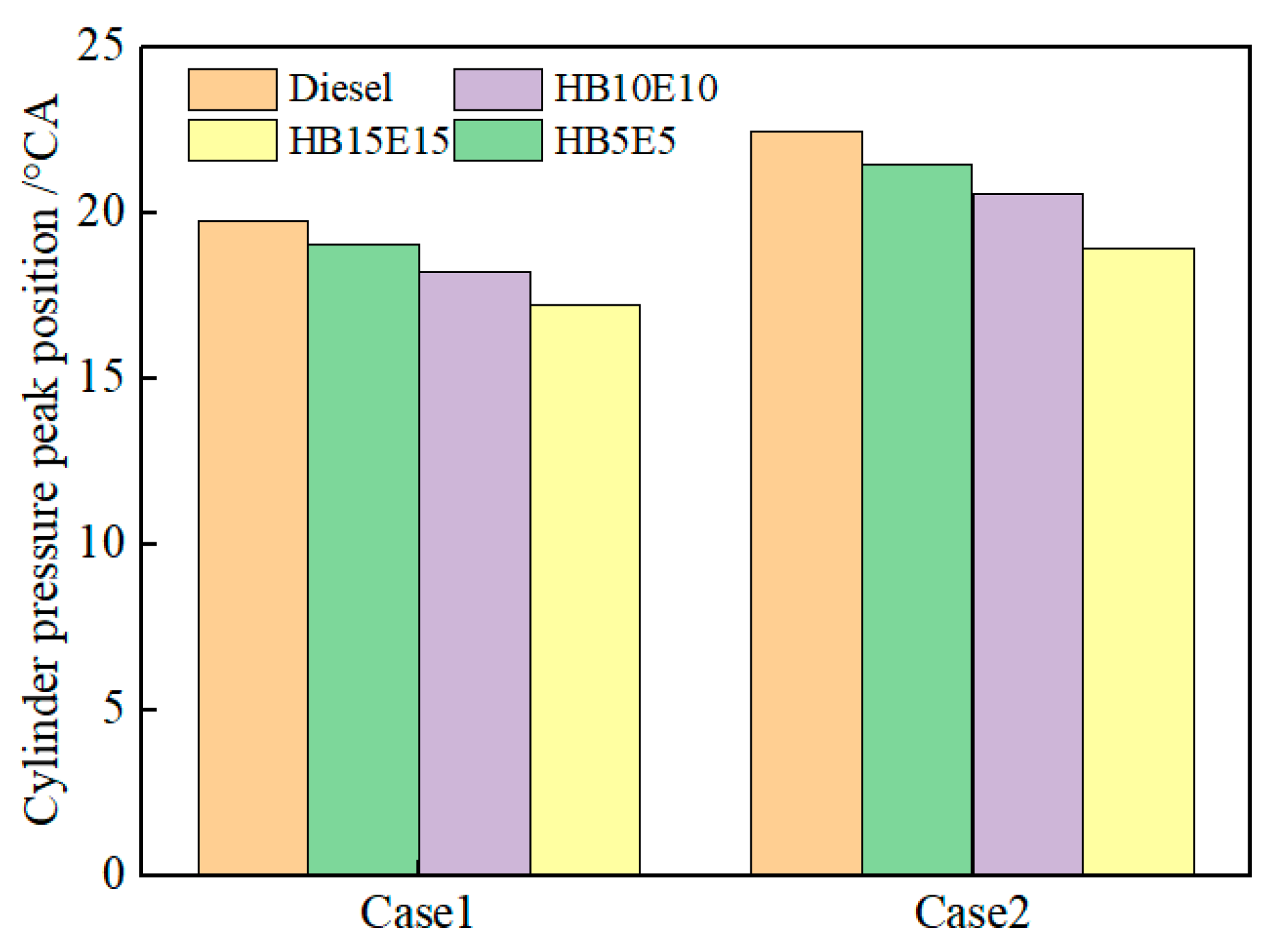







| Item | Parameter |
|---|---|
| Number of cylinders | 4 |
| Cylinder diameter | 95 mm |
| Piston stroke | 100 mm |
| Total piston displacement | 2.83 L |
| Calibrated power | 75 kW |
| Calibrated speed | 3200 r/min |
| Maximum torque | 250 N·m |
| Maximum speed | 1600~2800 r/min |
| Initial Condition | Boundary Parameter |
|---|---|
| Cylinder wall temperature | 407 K |
| Cylinder head temperature | 450 K |
| Combustion chamber top temperature | 478 K |
| Initial pressure | 1.8 MPa |
| Initial temperature | 403 K |
| Fuel Properties | Molecular Formula | Oxygen-Containing Functional Groups | Cetane | Lower Calorific Value | Oxygen Content |
|---|---|---|---|---|---|
| n-Heptane | nC7H16 | / | 54 | 41.8 MJ/kg | 0 |
| Hydrogenated biodiesel | C19H36.4O2 |  | 71.2 | 38.42 MJ/kg | 9.3 |
| Ethanol | C2H5OH |  | 35 | 15.78 MJ/kg | 53.4 |
| Lipid Structure Cetane Number | Lipid Structure Cetane Number | Lipid Structure Cetane Number |
|---|---|---|
| Methyl Palmitic acid |  | 86 |
| Methyl stearate |  | 104.1 |
| Methyl oleate |  | 62.3 |
| Methyl Linoleic acid |  | 38 |
| Methyl linolenic acid |  | 23 |
| Number Retention Time | Min Component | Name | Molecular Formula | Peak Area/% | |
|---|---|---|---|---|---|
| CME | PHCME | ||||
| 1 | 14.61 | methyl myristate (C14:0) | C15H30O2 | 0.13 | 0.12 |
| 2 | 17.23 | methyl palmitate (C16:0) | C17H34O2 | 23.05 | 23.07 |
| 3 | 21.19 | methyl stearate (C18:0) | C19H38O2 | 3.17 | 13.25 |
| 4 | 21.66 | Elaidic acid methyl ester (trans-C18:1) | C19H36O2 | 0 | 15.47 |
| 5 | 21.91 | Cis oleic acid methyl ester (cis-C18:1) | C19H36O2 | 21.47 | 30.48 |
| 6 | 23.18 | Linoleic acid methyl ester (C18:2) | C19H34O2 | 49.94 | 16.06 |
| 7 | 24.65 | Methyl linolenic acid (C18:3) | C19H32O2 | 1.56 | 0.87 |
| 8 | 25.89 | Arachidic acid methyl ester (C20:0) | C21H42O2 | 0.53 | 0.55 |
| 9 | 30.79 | Behenic acid methyl ester (C22:0) | C23H46O2 | 0.15 | 0.13 |
| Case | Scheme | SOI-P1 | SOI-M | QM | Q1 |
|---|---|---|---|---|---|
| Case 1 | Diesel-9 | −28 °CA | −9 °CA | 43 mg | 1.2 mg |
| HB5E5-9 | −28 °CA | −9 °CA | 43 mg | 1.2 mg | |
| HB10E10-9 | −28 °CA | −9 °CA | 43 mg | 1.2 mg | |
| HB15E15-9 | −28 °CA | −9 °CA | 43 mg | 1.2 mg | |
| Case 2 | Diesel-6 | −25 °CA | −6 °CA | 43 mg | 1.2 mg |
| HB5E5-6 | −25 °CA | −6 °CA | 43 mg | 1.2 mg | |
| HB10E10-6 | −25 °CA | −6 °CA | 43 mg | 1.2 mg | |
| HB15E15-6 | −25 °CA | −6 °CA | 43 mg | 1.2 mg |
Disclaimer/Publisher’s Note: The statements, opinions and data contained in all publications are solely those of the individual author(s) and contributor(s) and not of MDPI and/or the editor(s). MDPI and/or the editor(s) disclaim responsibility for any injury to people or property resulting from any ideas, methods, instructions or products referred to in the content. |
© 2023 by the authors. Licensee MDPI, Basel, Switzerland. This article is an open access article distributed under the terms and conditions of the Creative Commons Attribution (CC BY) license (https://creativecommons.org/licenses/by/4.0/).
Share and Cite
Zhou, J.; Zhang, R.; Xi, W.; Zhao, W. Computational Analysis on Combustion Control of Diesel Engines Fueled with Ester Alcohol Diesel. Energies 2023, 16, 6093. https://doi.org/10.3390/en16166093
Zhou J, Zhang R, Xi W, Zhao W. Computational Analysis on Combustion Control of Diesel Engines Fueled with Ester Alcohol Diesel. Energies. 2023; 16(16):6093. https://doi.org/10.3390/en16166093
Chicago/Turabian StyleZhou, Jianbo, Rui Zhang, Wenxiong Xi, and Weidong Zhao. 2023. "Computational Analysis on Combustion Control of Diesel Engines Fueled with Ester Alcohol Diesel" Energies 16, no. 16: 6093. https://doi.org/10.3390/en16166093
APA StyleZhou, J., Zhang, R., Xi, W., & Zhao, W. (2023). Computational Analysis on Combustion Control of Diesel Engines Fueled with Ester Alcohol Diesel. Energies, 16(16), 6093. https://doi.org/10.3390/en16166093







